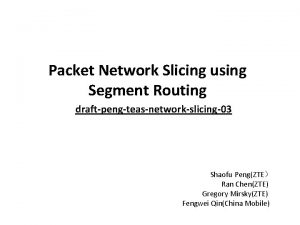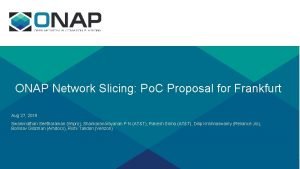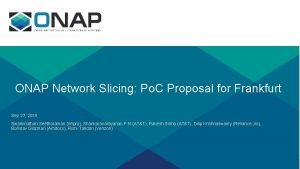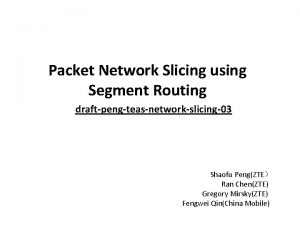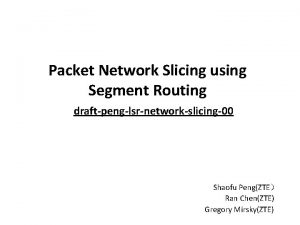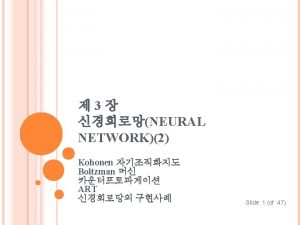Packet Network Slicing using Segment Routing draftpengteasnetworkslicing03 Shaofu









- Slides: 9

Packet Network Slicing using Segment Routing draft-peng-teas-network-slicing-03 Shaofu Peng(ZTE) Ran Chen(ZTE) Gregory Mirsky(ZTE) Fengwei Qin(China Mobile)

Existing Identifiers Overview REQ 1: Dedicated Virtual Networks REQ 2: End-to-End Slicing REQ 3: Unified NSI REQ 4: Traffic Engineering REQ 5: Layer 2 / Layer 3 link resource partition REQ 1 AG and EAG Bit Multi-Topology Identifier REQ 2 REQ 3 √ √ √ AII(Administrative Instance √ Identifier) REQ 5 √ SR Policy Color Flex-algorithm Identifier REQ 4 √ √ √ √ 2

AII Overview • AII (Administrative Instance Identifier): Explicit virtual network identification , it could be used as a TN-slice identifier, it indicates the topology, computing, storage resources of the dedicated virtual network. – – – • AII is the identifier of the dedicated Virtual Networks for the slice. Support the End-to-End Slicing. Identifier the Unified NSI across multi-domain of TN. AII is one of constraint criteria of the color template (draft-ietf-spring-segment-routing-policy) , and color template with AII provides a more flexible control. Uniform Color template (Centralized and distributed, intra and inter domain) for overlay service mapping to underlay resource. AII meet the link requirements from 3 GPP. It is independent of the existing domain partition of the network, i. e. , any intra- or inter-domain link, and it is also independent of the existing underlay frame or routing technologies (IGP, BGP, Segment Routing, Flex-E, etc. ), i. e. , any L 2 or L 3 link is the candidate resource. There is no modification to the forwarding table(dataplane). 3

AII as a TN-slice Identifier I. SR-policy@AII installed II. Flow steer to SR policy or SR-BE @AII Controller Slice config: • node/link join AIIs • SID allocation per AII SR policy@AII-1 color 1000(red) AII IS 1 te metric -1 AII H SR-BE@AII-1 == SR policy@AII-1 color 10(black) AII IS 1 igp metric NSI-2/AII-2 NSI-1/AII-1 1 BGP-LS (with AII attribute) AII 1 AII 2 default AII 2 AII-2 Transport Network E AII-2 3 AII 1 AII 2 4 -1 AII Create the TN-slice • Assign/Select the AII to the slice. • Allocate resources(v. Node, v. Link…) to AII 4. • AII information is advertised via Control plane

AII as a Set of TN-slice Resource Identifiers n L 3 Interface Slice Isolation AII 1 BE Path AII 1 TE Path AII 2 BE Path AII 1 R 1 L 3 -Parameters Flex-Client 2 AII 2 R 2 L 3 -Parameters AII 1 Flex-Client 1 L 3 -Parameters AII 2 Flex-Client 2 R 3 n L 2 Interface Slice Isolation AII 1 BE Path AII 1 TE Path AII 2 TE Path R 1 L 2 -member 1 for AII 1 Client 1 L 2 -member 2 for AII 2 Client 2 R 2 L 3 parameter for slice-bundles 1 L 2 -member 1 for AII 1 Client 1 L 2 -member 2 for AII 2 Client 2 R 3 L 3 parameter for slice-bundles 1 • L 2 Bundle members share the same IGP instance. • L 2 Bundle members could be any interface type. • Control-plane packets will always be forwarded over the same path. • Data-plane packets will be forwarded on the specific L 2 -bundle member. n Resource Isolation • SIDs are allocated per AII, and the resource (such as bandwidth ) is allocated to AII. • AII is one of constraint criteria of the Color Template (draft-ietf-spring-segment-routing-policy) , and color template with AII and other traditional criteria, such as bandwidth, delay, affinity, provide a more flexible control. 5

AII for Multi-Domain Deployment color 1000 is: AII 1 SPF Option C: Colored BGP-LU without SDN BGP-LU for <color=1000, prefix=PE 2> SR-BE PE 1 SR-BE color 1001 is: AII 1 te metric ASBR 2 ASBR 1 SR-TE PE 2 SR-TE sub-if 1 belong to AII-1 AS 1 BGP-LU for <color=1001, prefix=PE 2> AS 2 ASBR selects AII-specific out-link according to uniform Color Template. Option B Inter-domain color 1000 is: AII 1 SPF color 1001 is: AII 1 bandwidth 1 G delay 10 ms VPN 1 LSP need <color=1000> SR-BE PE 1 SR-TE AS 1 ASBR 2 sub-if 1 belong to AII-1 VPN 2 LSP need <color=1001> SR-BE SR-TE PE 2 ASBR selects AII-specific out-link according to uniform Color Template. 6

All for Multi-Domain Deployment Cont. E 2 E SR-TE with SDN Controller • BGP-LS advertised link-state NLRI containing AII information. • For the inter-domain link, BGP-LS can advertise DIRECT protocol type, or firstly put interdomain interconnections to IGP instance, then always import data from IGP protocol source. • Controller supports computation of E 2 E TE path based on TE-DB with AII attribute. 7

Combined with SR Flex-algorithm Scenario 1: For inter-AS case, SDN controller can create VN for AII-AS based on AII, and VN for FA-AS based on FA respectively. SDN controller computes E 2 E segment lists, each containing multiple ASes and based on different technologies. sr-policy <policy-name> end-point <dest-ip> color <value> path-setup-type {sr-mpls | srv 6} H-Ctrl D-Ctrl slice 1. TE 1 Color 1001 BG PC P-L Ne EP, S, tco nf ig BG Ne P-LS tco , nfi g flex-algorithm fa-id //128~255 algorithm-definition priority <value> metric-type {igp | te | delay} exclude-any <value> include-any|include-all <value> fa-id 128 fa-id. ASBR 129 2 fa-id 130 ASBR 1 slice 1. TE 2 Color 1002 PE 1 slice 2. TE 1 Color 1003 D-Ctrl PE 2 AS 2 with SR FA AS 1 with AII color-template <value> mapping fa-id sr-policy <policy-name> end-point <dest-ip> color <value> path-setup-type {sr-mpls | srv 6} color-template <value> AII metric-type {igp | te | delay} exclude-any <value> include-any|include-all <value> flex-algorithm fa-id //128~255 algorithm-definition priority <value> Ctrl -LS, BGP onfig c Net AII metric-type {igp | te | delay} exclude-any <value> include-any|include-all <value> sr-policy <policy-name> end-point <dest-ip> color <value> path-setup-type {sr-mpls | srv 6} BGP Net -LS, con fig slice 1. TE 1 Color 1001 slice 1. TE 2 Color 1002 PE 1 slice 2. TE 1 Color 1003 fa-id 128 enable fa-id 129 enable fa-id 130 enable P PE 2 fa-id 128 enable fa-id 129 enable fa-id 130 enable Single AS with AII color-template <value> mapping fa-id Scenario 2: For a single AII-AS, we can continue to apply SR FA to optimize label stack depth. In this case, a new criteria AII is added in FAD, 8 same as adding AII to Color Template.

Next Step • Comments welcome. Thanks! 9
